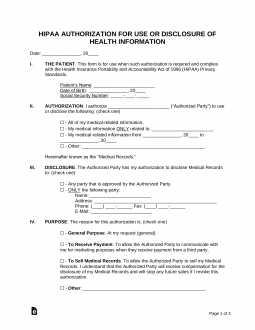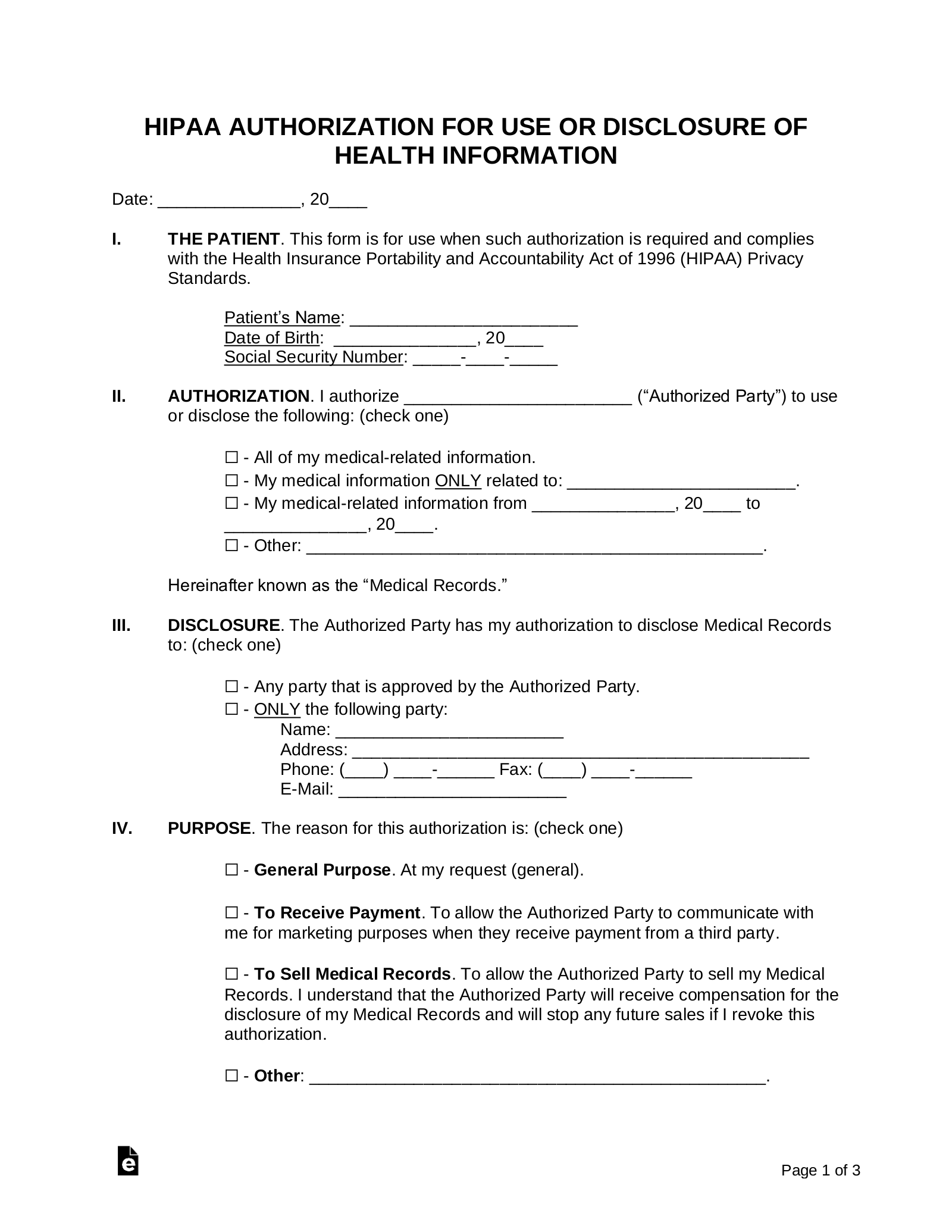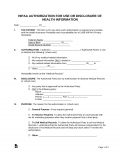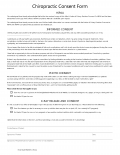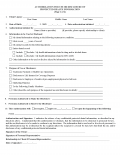Updated February 01, 2024
The medical record information release (HIPAA) form allows patients to give authorization to a 3rd party and access their health records. It also allows the added option for healthcare providers to share information.
Powers granted under a medical release can be revoked or reassigned at any time.
Laws – 45 C.F.R. Part 160 and 45 C.F.R. Part 164
What does HIPAA stand for?
Health Insurance Portability and Accountability Act
Table of Contents |
By State
- Alabama
- Alaska
- Arizona
- Arkansas
- California
- Colorado
- Connecticut
- Delaware
- Florida
- Georgia
- Hawaii
- Idaho
- Illinois
- Indiana
- Iowa
- Kansas
- Kentucky
- Louisiana
- Maine
- Maryland
- Massachusetts
- Michigan
- Minnesota
- Mississippi
- Missouri
- Montana
- Nebraska
- Nevada
- New Hampshire
- New Jersey
- New Mexico
- New York
- North Carolina
- North Dakota
- Ohio
- Oklahoma
- Oregon
- Pennsylvania
- Rhode Island
- South Carolina
- South Dakota
- Tennessee
- Texas
- Utah
- Vermont
- Virginia
- Washington
- West Virginia
- Wisconsin
- Wyoming
By Type (4)
Download: PDF
Download: PDF
Download: PDF
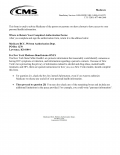 Medicare HIPAA (Form CMS-10106)
Medicare HIPAA (Form CMS-10106)
Download: PDF
How to Get Medical Records (3 steps)
Accessing and obtaining your medical records is a requirement under 45 CFR 164.524 which requires that any request made to access or transfer medical records must be completed within 30 days, or a letter must be sent to the requestor stating why the records are delayed.
1. Request the Medical Records

To legally request medical records, under 45 CFR 164.524(b)(1), the entity holding the records may require that the request is made in writing. Therefore, use the Standard Form and use the “How to Write” section of this page to enter the specific fields required to complete.
The 4 sections are:
- Releasor and Recipient – Who has the medical records, and to who will they be sending them?
- Time Period – What dates are authorized for release?
- Record Types – Should only specific records be released about certain medical conditions, or should all the patient’s records be released?
- Expiration Date – Usually, a date is listed at which it expires for legal purposes.
2. Send the Letter

When sending the letter to the medical facility it is best to request how the record should be sent; examples include, an electronic document (PDF, Word), USB Flash Drive, CD, etc. The medical facility may charge a fee for sending the records, although, they are prohibited from charging for processing the request.
3. Receive the Medical Records

Modern medical facilities are typically aware that time is of the essence in regards to the records of an individual. Therefore, if the requested information is not received within 5 to 7 business days the requestor should call or ask to know the status of the transfer.
The medical facility has 30 days to release the requested medical records. If the initial 30-day period is not met they may extend for an additional 30 days only if they send a letter to the requestor stating why the transfer is delayed. Only one (1) extension period is allowed by law.
Getting for Someone Else (3 options)
Under 45 CFR § 164.502(g), an individual may obtain medical records on behalf of someone else.
1. Personal Representative

An individual, such as an attorney-in-fact (or “agent”) mentioned in a Medical Power of Attorney, commonly has powers to obtain medical records. In addition, for any person that has been appointed by a court to act as a caregiver or guardian, the judgment, order, or decree must be attached to the HIPAA release form.
3. Administrator of an Estate

An administrator, personal representative, executor, or another authorized person with the authority to act on the deceased person’s estate. Suppose, for any reason, the medical records of the deceased are requested. In that case, the administrator appointed in the Last Will and Testament or a court-appointed authority may be able to obtain the records.
Is There a Fee ($) to Release Medical Records?
Yes, but this depends on the medical office and the state it is located. Generally speaking, smaller offices do not require a fee for copying and transferring medical records. If a medical office does charge a fee, it cannot be more than the statutory limit (see table below):
State-by-State Maximum Limits ($)
| State | Maximum Fees ($) | Laws |
| Alabama | Search Fee: $5
Pages 1-25: $1/page Pages 26+: $0.50 Other Documents: Actual cost of reproduction. |
§ 12-21-6.1 |
| Alaska | N/A | No Statute |
| Arizona | Reasonable Fee | § 12-2295 |
| Arkansas | Search Fee: $15
Pages 1-25: $0.50/page Pages 26+: $0.25/page |
§ 16-46-106 |
| California | Search Fee: $4
Evidence Fee: $15 Pages 1+: $0.10/page Microfilm: $0.20/page |
EVID Code § 1158(2) & § 1563(6) |
| Colorado | Search Fee: $18.53 flat fee (First ten pages)
Pages 11 – 40: $0.85 per page Pages 41+: $0.57 per page Microfilm: $1.50 per page |
6CCR 1011-1 Chapter 2 Part 5.2.3.4 |
| Connecticut | Pages 1+: $0.65 per page | § 19a-490b |
| Delaware | Pages 1 – 10: $2.00 per page
Pages 11 – 20: $1.00 per page Pages 21 – 60: $0.90 per page Pages 61+: $0.50 per page Microfilm: Actual cost of reproduction. |
Title 24: Chapter 1700, Section 29 |
| Florida | Search Fee: $1.00 (Per year per request)
Pages 1+: $1.00 per page Microfilm: $2.00 per page |
§ 395.3025 (1) |
| Georgia | Search Fee: $25.88
Pages 1 – 20: $0.97 per page Pages 21 – 100: $ 0.83 per page Pages 101+: $0.66 per page Certification Fee: $9.70 |
§ 31-33-3 |
| Hawaii | Reasonable Fee | § 622-57(g) |
| Idaho | N/A | No Statute |
| Illinois | Search Fee: $29.09
Pages 1 – 25: $1.09 per page Pages 26 – 50: $0.73 per page Pages 50+: $0.36 per page Microfilm: $1.82 per page |
735 ILCS 5/8-2005 |
| Indiana | Search Fee: $20.00 (includes first 10 pages)
Pages 11 – 50: $0.50 per page Pages 51+: $0.25 per page Affidavit/Certification: $20.00 |
760 IAC 1-71-3(a) |
| Iowa | Reasonable Fee | § 622.10 |
| Kansas | Reasonable Fee | REPEALED |
| Kentucky | First (1st) Copy: Free
Second (2nd) Copy: $1.00 per page |
§ 422.317 |
| Louisiana | Search Fee: $25.00
Pages 1 – 25: $1.00 per page Pages 26 – 350: $0.50 per page Pages 351+: $0.25 per page Max Fee for Electronic Records: $100.00 per request |
§ 1165.1 |
| Maine | Search Fee: $5.00 (Includes first page)
Pages 2+: $0.45 per page Max Fee: $250.00 Max Fee for Electronic Records: $150.00 per request |
§ 1711-A |
| Maryland | Search Fee: $22.88
Pages 1+: $0.83 per page Electronic Records Search Fee: $22.88 Electronic Records Pages 1+: $0.62 per page Max Fee for Electronic Records: $81.63 per request |
§ 4-304 |
| Massachusetts | Search Fee: $25.01
Pages 1 – 100: $0.84 per page Pages 100+: $0.43 per page Social Security: No charge for a request to support a claim under the social security act. |
Title XVI, Ch III, Section 70 |
| Michigan | Search Fee: $25.38
Pages 1 – 20: $1.27 per page Pages 21 – 50: $0.63 per page Pages 51+: $0.25 per page |
Public Act 47 of 2004. MCL 333.26269 |
| Minnesota | Search Fee: $19.19
Pages 1+: $1.44 per page X-rays: $10 Search Fee plus the actual cost of reproduction. |
§ 144.292 |
| Mississippi | Search Fee: $20.00 Flat Fee (first 20 pages)
Pages 21 – 100: $1.00 per page Pages 101+: $0.50 per page Search/Storage Fee: $15.00 (Only charged if records are retrieved from off-site location) Certification Fee: $25.00 |
§ 11-1-52 |
| Missouri | Search Fee: $26.06
Pages 1+: $0.60 per page Storage Fee: $24.40 (Additional fee if records are retrieved off-site) Max Fee for Electronic Records: $114.17 |
§ 191.227.5 |
| Montana | Search Fee: $15.00
Pages 1+: $0.50 per page |
§ 50-16-540 |
| Nebraska | Search Fee: $20.00
Pages: 1+: $0.50 per page X-rays: Actual cost of reproduction. |
§ 71-8404 |
| Nevada | Pages 1+: $0.60 per page
X-rays: Reasonable Fee |
§ 629.061 |
| New Hampshire | Whichever is greater: $15 for first 30 pages or $0.50 per page X-rays: Reasonable Fee |
§ 332-I |
| New Jersey | Search Fee: $10.00
Pages 1 – 100: $1.00 per page Pages 101+: $0.25 per page Max Fee: $200.00 |
§ 8:43G-15.3, § 13:35-6.5 |
| New Mexico | Pages 1 – 15: $30.00 flat fee
Pages 16+: $0.25 per page X-rays: Actual cost of reproduction. |
§ 16.10.17.8 |
| New York | Pages 1+: $0.75 per page
X-rays: Actual cost of reproduction. |
Title 2: Section 17 |
| North Carolina | Pages 1 – 25: $0.75 per page
Pages 26 – 100: $0.50 per page Pages 100+: $0.25 per page Minimum Fee: $10.00 |
§ 90-411 |
| North Dakota | Search Fee: $20.00 (Includes pages 1-25)
Pages 26+: $0.75 per page Electronic Records Search Fee: $30.00 (Includes pages 1-25) Electronic Records Pages 26+: $0.25 per page |
§ 23-12-14 |
| Ohio | Search Fee: $20.42
Pages 1 – 10: $1.34 per page Pages 11 – 50: $0.69 per page Pages 51+: $0.27 per page X-rays: Search Fee plus $2.27 per page |
§ 3701.742 |
| Oklahoma | Search Fee: $10.00
Pages 1+: $0.30 per page X-rays: $5.00 per page Max Fee: $200.00 |
§ 76-19 |
| Oregon | Search Fee: $30.00 (Includes pages 1-10)
Pages 11-50: $0.50 per page Pages 51+: $0.25 per page X-rays: Actual cost of reproduction. |
OAR 847-012-0000 |
| Pennsylvania | Search Fee: $23.45
Pages 1 – 20: $1.58 per page Pages 21 – 60: $1.17 per page Pages 61+: $0.40 per page Microfilm: $23.45 + $2.33 per page |
48 Pa.B. 7712 |
| Rhode Island | Pages 1 – 10: $2.50 per page
Pages 10 – 50: $0.75 per page Pages 51+: $0.50 per page |
R5-37- MD/DO Section 11.2 |
| South Carolina | Search Fee: $26.67
Pages 1 – 30: $0.69 per page Pages 31+: $0.53 per page Max Fee for Electronic Records: $160.05 |
§ 44-115-80 |
| South Dakota | No Current Fee Schedule | § 36-2-16 |
| Tennessee | Search Fee: $18.00 (Includes pages 1 – 5)
Pages 6 – 50: $0.85 per page Pages 51 – 250: $0.60 per page Pages 251+: $0.35 per page |
§ 63-2-102 |
| Texas | Search Fee: $48.77 (Includes pages 1 – 10)
Pages 11 – 60: $1.64 per page Pages 61 – 400: $0.80 per page Pages 401+: $0.44 per page |
§241.154 |
| Utah | Search Fee: $21.16
Pages 1 – 40: $0.53 per page Pages 41+: $0.32 per page |
78B-5-618 |
| Vermont | Whichever is greater: $5 or $0.50 per page
Social Security: No charge for a request to support a claim under the social security act. |
§ 9419 |
| Virginia | Search Fee: $20.00
Pages 1 – 50: $0.50 per page Pages 51+: $0.25 per page Max Fee: $150.00 Electronic Records Search Fee: $20.00 Electronic Records Pages 1 – 50: $0.37 per page Electronic Records Pages 51+: $0.18 per page Electronic Records Max Fee: $150.00 Microfilm Search Fee: $20.00 Microfilm Pages 1+: $1.00 per page |
§ 8.01-413 |
| Washington | Search Fee: $26.00
Pages 1 – 30: $1.17 per page Pages 31+: $0.88 per page |
WAC 246-08-400 |
| West Virginia | Search Fee : $20.00
Pages 1+ : $0.40 per page Pages 1+ Electronic Records: $0.20 per page Max Fee Electronic Records: $150 |
§ 16-29-2 |
| Wisconsin | Search Fee: $22.61
Pages 1 – 25: $1.14 per page Pages 26 – 50: $0.86 per page Pages 51 – 100: $0.56 per page Pages 101+ $0.34 per page Microfilm and other media: $22.19 + $1.68 per page X-rays : $22.19 + $11.28 per series Certification (if not patient or their representative): $9.04 per request |
§ 146.83 (3f)(c)2 |
| Wyoming | N/A | No Statute |
Sample
Download: PDF, MS Word, OpenDocument
HIPAA AUTHORIZATION FOR USE OR DISCLOSURE OF HEALTH INFORMATION
Date: [DATE]
I. THE PATIENT. This form is for use when such authorization is required and complies with the Health Insurance Portability and Accountability Act of 1996 (HIPAA) Privacy Standards.
Patient’s Name: [PATIENT’S NAME]
Date of Birth: [DATE OF BIRTH]
Social Security Number: [SSN]
II. AUTHORIZATION. I authorize [AUTHORIZED PARTY’S NAME] (“Authorized Party”) to use or disclose the following: (check one)
☐ – All of my medical-related information.
☐ – My medical information ONLY related to: [ENTER MEDICAL CONDITION]
☐ – My medical-related information from [DATE] to [DATE].
☐ – Other: [OTHER]
Hereinafter known as the “Medical Records.”
III. DISCLOSURE. The Authorized Party has my authorization to disclose Medical Records to: (check one)
☐ – Any party that is approved by the Authorized Party.
☐ – ONLY the following party:
Name: [RECIPIENT’S NAME]
Address: [ADDRESS]
Phone: [PHONE] Fax: [FAX]
E-Mail: [E-MAIL]
IV. PURPOSE. The reason for this authorization is: (check one)
☐ – General Purpose. At my request (general).
☐ – To Receive Payment. To allow the Authorized Party to communicate with me for marketing purposes when they receive payment from a third party.
☐ – To Sell Medical Records. To allow the Authorized Party to sell my Medical Records. I understand that the Authorized Party will receive compensation for the disclosure of my Medical Records and will stop any future sales if I revoke this authorization.
☐ – Other: [OTHER]
V. TERMINATION. This authorization will terminate: (check one)
☐ – Upon sending a written revocation to the Authorization Party.
☐ – On the following date: [DATE]
☐ – Other: [OTHER]
VI. ACKNOWLEDGMENT OF RIGHTS.
I understand that I have the right to revoke this authorization, in writing and at any time, except where uses or disclosures have already been made based upon my original permission. I might not be able to revoke this authorization if its purpose was to obtain insurance.
I understand that uses and disclosures already made based upon my original permission cannot be taken back.
I understand that it is possible that Medical Records and information used or disclosed with my permission may be re-disclosed by a recipient and no longer protected by the HIPAA Privacy Standards.
I understand that treatment by any party may not be conditioned upon my signing of this authorization (unless treatment is sought only to create Medical Records for a third party or to take part in a research study) and that I may have the right to refuse to sign this authorization.
I will receive a copy of this authorization after I have signed it. A copy of this authorization is as valid as the original.
Signature of Patient: __________________________ Date: ________________
Print Name: ________________________
(IF THE PATIENT IS UNABLE TO SIGN, USE THE SIGNATURE AREA BELOW)
The patient is unable to sign due to: (check one)
☐ – Being a Minor. Patient is [#] years old and a minor under state law.
☐ – Being Incapacitated. Patient is incapacitated due to: [DESCRIBE CONDITION]
☐ – Other: [OTHER]
Signature of Representative: __________________________ Date: ________________
Print Name: ________________________
Relationship to Patient: ☐ Parent ☐ Spouse ☐ Guardian ☐ Other: [OTHER]
ADDITIONAL CONSENT FOR CERTAIN CONDITIONS
I. SENSITIVE INFORMATION. This medical record may contain information about physical or sexual abuse, alcoholism, drug abuse, sexually transmitted diseases, abortion, or mental health treatment. Separate consent must be given before this information can be released.
(check one)
☐ – I consent to have the above information released.
☐ – I do not consent to have the above information released.
Signature of Patient: __________________________ Date: __________________
Print Name: ________________________
II. HIV/AIDS. This medical record may contain information concerning HIV testing and/or AIDS diagnosis or treatment. Separate consent must be given to have this information released.
(check one)
☐ – I consent to have the above information released.
☐ – I do not consent to have the above information released.
Signature of Patient: __________________________ Date: __________________
Print Name: ________________________
Related Forms
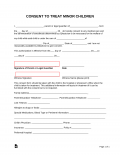 Minor (Child) Medical Consent – To elect someone else to have medical decision-making responsibilities for a minor child.
Minor (Child) Medical Consent – To elect someone else to have medical decision-making responsibilities for a minor child.
Download: PDF, MS Word, OpenDocument
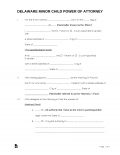 Minor (Child) Power of Attorney – Also known as a ‘consent’ form that authorizes a family member, friend, or guardian to have the responsibility to make education, medical, and everyday living decisions.
Minor (Child) Power of Attorney – Also known as a ‘consent’ form that authorizes a family member, friend, or guardian to have the responsibility to make education, medical, and everyday living decisions.
Download: PDF, MS Word, OpenDocument
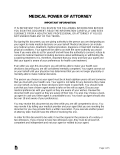 Medical Power of Attorney – May be used by anyone to give someone else the responsibility of handling their medical needs only if the patient is not able to speak for themselves.
Medical Power of Attorney – May be used by anyone to give someone else the responsibility of handling their medical needs only if the patient is not able to speak for themselves.
Download: PDF, MS Word, OpenDocument
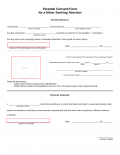 Parental Consent for a Minor’s Abortion – To be used in States that require the consent of a parent or guardian for an individual under eighteen (18) years of age to receive an abortion.
Parental Consent for a Minor’s Abortion – To be used in States that require the consent of a parent or guardian for an individual under eighteen (18) years of age to receive an abortion.
Download: PDF

